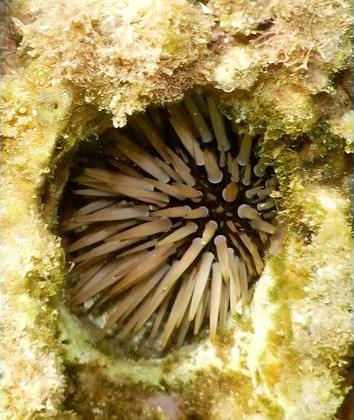Published in the Ocean Watch column, Honolulu Star-Advertiser © Susan Scott
April 27, 2015
Rock-boring sea urchins have riddled the reef in so many parts of my favorite snorkeling area, it’s a wonder there are any rocks left at all.
Some of the bowl-shaped caves that the urchins call home are so enclosed, it looks as if the spiky little creatures, which come in pink, green, cream and black, can’t possibly get out. If hemmed in a hollow for life, what do the rock-borers eat? And how did they manage to get in so deep?
 Rock-boring sea urchins are vegetarians.
Rock-boring sea urchins are vegetarians.
©2015 Susan Scott
They chewed their way in.
Rock-boring urchins have thick, stubby, nonvenomous spines sticking out from their spheroid skeletons except at the bottom. In the center of the flat space beneath is the urchin’s mouth containing five sharp teeth fused together in a circle called Aristotle’s lantern.
The name comes from Aristotle himself, who described sea urchin teeth (all species are similar) as looking like a five-sided lantern with the panes left out.
When you live in the shallow ocean and grow to only 2.5 inches across, including spines, most waves would bowl you over. To hang on against such force, rock-borers use their round set of teeth to gnaw into limestone or volcanic rock, and thus create their own personal tsunami shelters.
Chewing rocks sounds hard on the teeth, but sea urchin teeth are renewable, growing with built-in breaking points. When a tooth gets worn down, it snaps off at the weak point, exposing a sharp new edge.
The rock-boring urchin also uses its bottom and side spines to scour and scrape. That’s why, in most individuals, the working lower spines are shorter than the slackers on top.
Rock-boring urchins get no nutrients from rocks.
The animals are vegetarians that, when able, come and go from their caverns to graze on algae. Even as the urchins grow bigger and dig deeper, their movable spines allow them to elbow their way in and out of their holes.
Some rock-borers excavate tunnels with open ceilings of various widths. The urchin can get in and out at the wide spots and hunker down where the skylights narrow.
Other urchins grow too big to get out the door. Housebound urchins simply eat in, which is how they get too large to leave. The individuals eat algae that grow in their cave, plus waves and currents offer free delivery.
Rock-borers are a central part of natural erosion cycles. Because urchin predators are mostly reef fish, in areas of heavy fishing, rock-boring urchins cause far more damage to the reefs than they would normally.
Now that I know how remarkable these urchins are, I see them in a hole new light. (Sorry.) Rock-boring urchins are anything but boring.